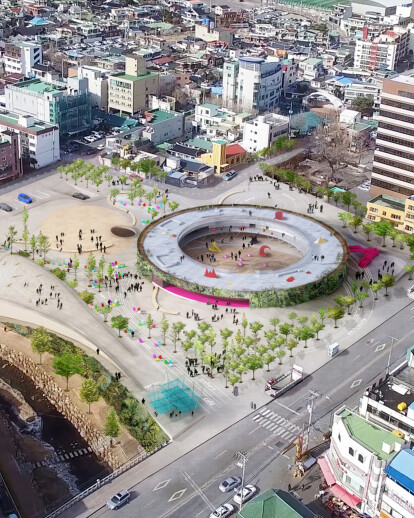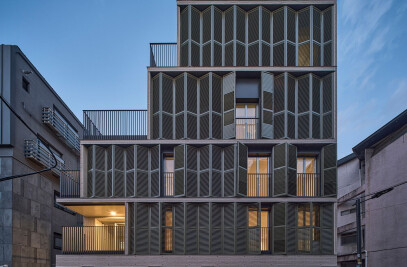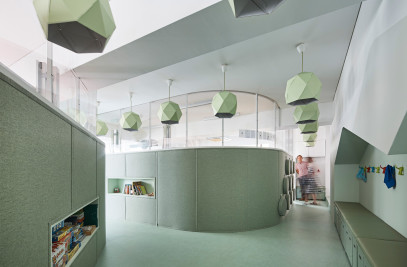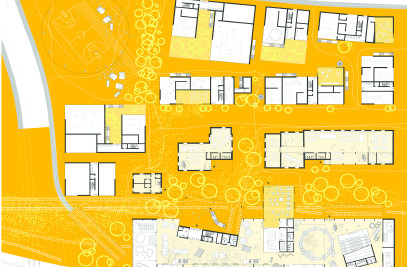GENERAL APPROACH Suncheon Bay is famous for its natural sceneries. The privileged location in the junction of the Dong and Isa streams is house of the widest reed bed in South Korea. Among the world’s wetlands, Suncheon Bay is widely known for attracting the largest number of rare birds.Suncheon Bay represents the best of the region and has been always the epicenter of tourism. We would like to propose for the Suncheon Art Platform competition an urban reinterpretation of the natural sceneries of Suncheon Bay. We wish to connect the collective memory of the bay with a new cultural and urban life in the city center of Suncheon where Culture and Nature become the raw materials to fabricate a new creative platform for citizens to enjoy and express themselves.
ARCHITECTURE AND URBAN SPACE The new Suncheon Art Platform proposes a fresh dialogue between architecture and public space. While architecture remains iconic and differentiated from buildings in the city, the public space tries to embrace all cultural activities under one same concept. A topography resembling Suncheon Bay’s circular geometries facilitates a continuous public platform for culture. The inclination of the surfaces qualifies the character of the public space and the potential artistic activities to be performed. The topography also allows for a seamless continuation of culture from the interior of the Art Center (the building with its exhibition spaces) to the exterior “plaza”. It is the intention of the design proposal to blur the dichotomy between art performed inside a cultural institution and art performed publicly. Finally, the topography of the “cultural plaza” allows citizens to reach the roof of the building without apparent efforts.
CULTURE, ARTIFICAL, NATURAL The City is artificial by nature. Streets, buildings, underground tunnels, infrastructure above and below ground, vehicles, wifi networks, street lighting and many other urban elements make the city truly artificial.
Culture is also artificial. Culture is the manipulation and interpretation of the natural world. We believe a public space charged with culture must be artificial and clearly man-made. Therefore, the pavement of the open spaces is a combination of various artificial materials such as wood decks, concrete, rubber, artificial flower gardens or compacted soil. But Nature is fundamental for citizens and, therefore, there is a need for green spaces in the city. Our proposal for the Suncheon Art Platform wishes to insert Nature in the city center, both on a memory and a physical level. Most of the proposed natural elements are concentrated in the building while the “cultural plaza” remains artificial.
The “cultural plaza” extends all over the site and it defines multiple situations through the use of topography. The upper levels of the “plaza” are also to contemplate the views towards the river and to get some fresh breeze. The lower areas are open to collective configuration and artistic expression.
PARTICIPATION We wish citizens to express their artistic talents by creating a flexible urban furniture system where everyone can configure at any time the way you wish to seat and communicate with others. Various hundreds of colorful chairs are distributed along the cultural plaza to be moved. Every evening, the “cultural plaza” leaves the traces of peoples activities during the day. Every morning a new configuration is possible. This dynamism and changeability is fundamental for citizens to participate and engage.
GENERAL SITE LAYOUT The Art Center’s main building is located in the east side of the plot towards Jungang-ro road. This position, together with the fact that the building is elevated, will project a significant image to visitors coming from the north and south of Jungang-ro road. From Jungang-ro road there is a smooth access to the build as well as to the open spaces labeled as“cultural plaza”. On the west side of the plot is located an underground parking with s small number of parking places on surface. The vehicle access is from Yeongdong-ro eliminating any potential conflict with pedestrian paths.
On the south part of the plot the surface of the plaza unfolds in various directions to create space to the cafeteria and the Yeong-jaru as well to create a connection to the stream. Above the cafeteria’s roof citizens can sit contemplating the stream from an elevated position. The Yeong-jary is located in the south-east corner of the plot so that it is visible from all directions.

































